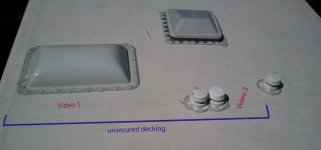rbonner
Member
We purchased a 2012 Bighorn Ti32 last fall  , love it except...
, love it except...
This spring I discovered that the end of the deck panel just behind the bathroom skylight was no longer secured to the roof truss. It will move down a 1/4 inch or so before it makes contact with the truss. In line accross the roof from this (towards the door), there is also another short section of panel next to the vents that can be pressed down (thumb pressure) and makes no contact with a support/truss .
.
Heartland Service, who does not consider this as a warranty item, tells me that this is "...where they run our wire channel across the roof and they have never had an issue with it, it will not affect the structure of the unit". They also tell me that this is not uncommon. Has anyone else experienced simmilar issues?
Is it something that I should not worry about? ...I have concerns over structural integrity first, and loss of re-sale value second.
...I have concerns over structural integrity first, and loss of re-sale value second.
This spring I discovered that the end of the deck panel just behind the bathroom skylight was no longer secured to the roof truss. It will move down a 1/4 inch or so before it makes contact with the truss. In line accross the roof from this (towards the door), there is also another short section of panel next to the vents that can be pressed down (thumb pressure) and makes no contact with a support/truss
Heartland Service, who does not consider this as a warranty item, tells me that this is "...where they run our wire channel across the roof and they have never had an issue with it, it will not affect the structure of the unit". They also tell me that this is not uncommon. Has anyone else experienced simmilar issues?
Is it something that I should not worry about?

